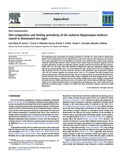Diet composition and feeding periodicity of the seahorse Hippocampus barbouri reared in illuminated sea cages

View/Open
Date
2012Author
Page views
347Metadata
Show full item recordCited times in Scopus
81 readers on Mendeley
- Citations
- CrossRef - Citation Indexes: 9
- Scopus - Citation Indexes: 14
- Captures
- Mendeley - Readers: 80
- Mentions
- Wikipedia - References: 1
Share
Abstract
The zooplankton prey composition and feeding periodicity of juvenile and adult seahorses Hippocampus barbouri reared in illuminated and non-illuminated sea cages were compared. Mean frequency of occurrence (%FO), prey composition (%N), and gut fullness of seahorses were calculated from analyses of gut contents. Compared with juvenile seahorses, adults consumed more variety of prey consisting of copepods, larvae of decapods, polychaetes and fish, and euphausid shrimps. Calanoid copedods were found in the gut of more juvenile (%FO = 47) and adult (%FO = 64) seahorses in illuminated cages but harpacticoid copepods were ingested by more juvenile fish (%FO = 50) in non-illuminated cages. Decapod larvae (%N = 66) in illuminated cages dominated the diet of juvenile seahorses, whereas in non-illuminated cages harpacticoid copepods (%N = 59) did. Calanoid copepods and decapod larvae (%N = 91–97) comprised the bulk of ingested prey among adult seahorses in all experimental cages. The gut of caged seahorses was generally full during daytime but declined in the evening, becoming almost empty at midnight, particularly among juveniles. Cage illumination commencing at midnight increased the number of filled guts at dawn (0400 h) among juvenile and adult seahorses. Unlike adult seahorses over a 24-h period, the overall incidence of filled guts among juveniles was not different between those in non-illuminated and illuminated cages. These results provide an alternative to growing caged H. barbouri on cultured live food, particularly copepods attracted by night illumination.
Suggested Citation
Garcia, L. M., Hilomen-Garcia, G. V., Celino, F. T., Gonzales, T. T., & Maliao, R. J. (2012). Diet composition and feeding periodicity of the seahorse Hippocampus barbouri reared in illuminated sea cages. Aquaculture , 358-359, 1-5. https://doi.org/10.1016/j.aquaculture.2012.06.013
Subject
Collections
- AQD Journal Articles [1248]

